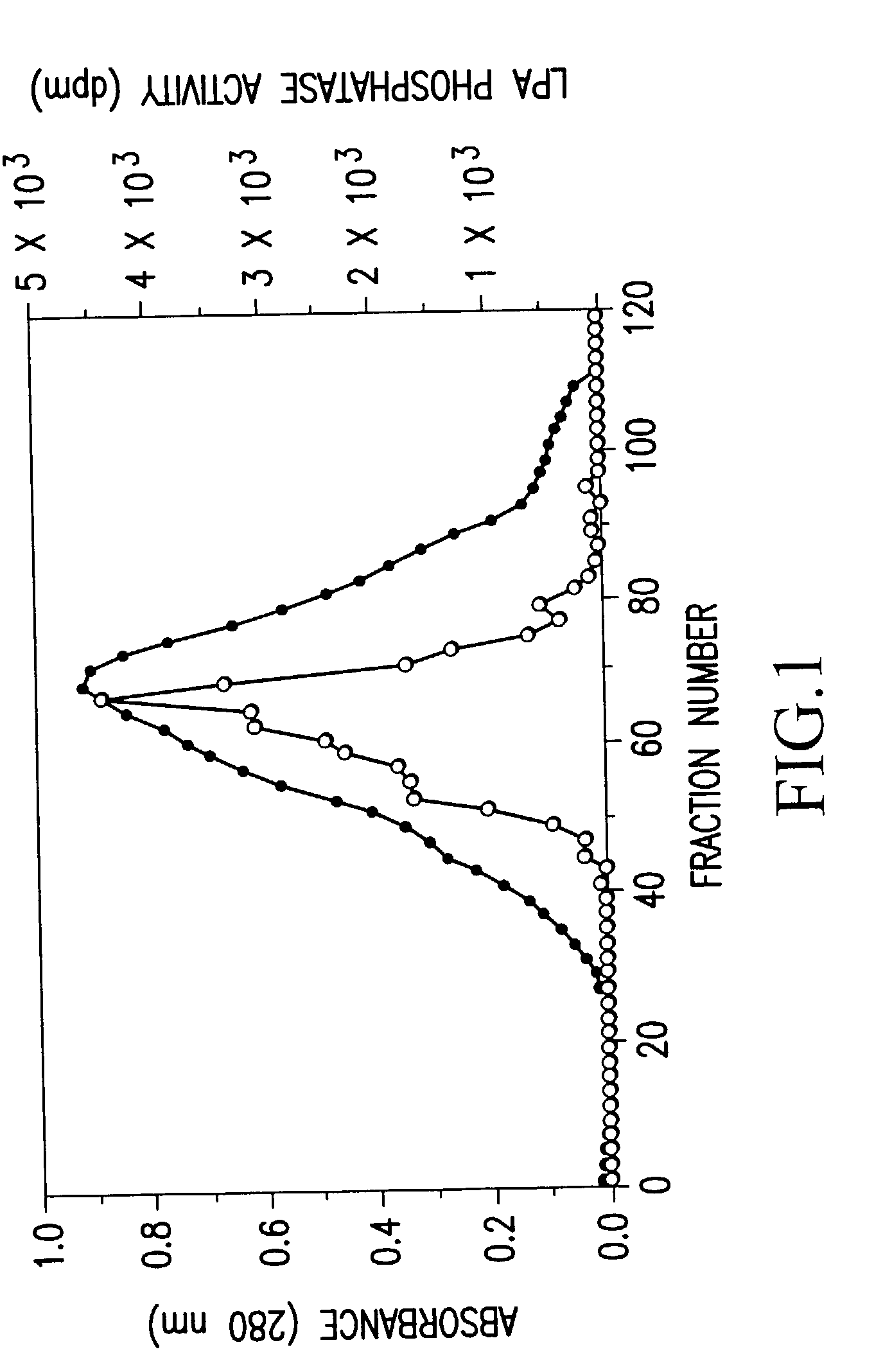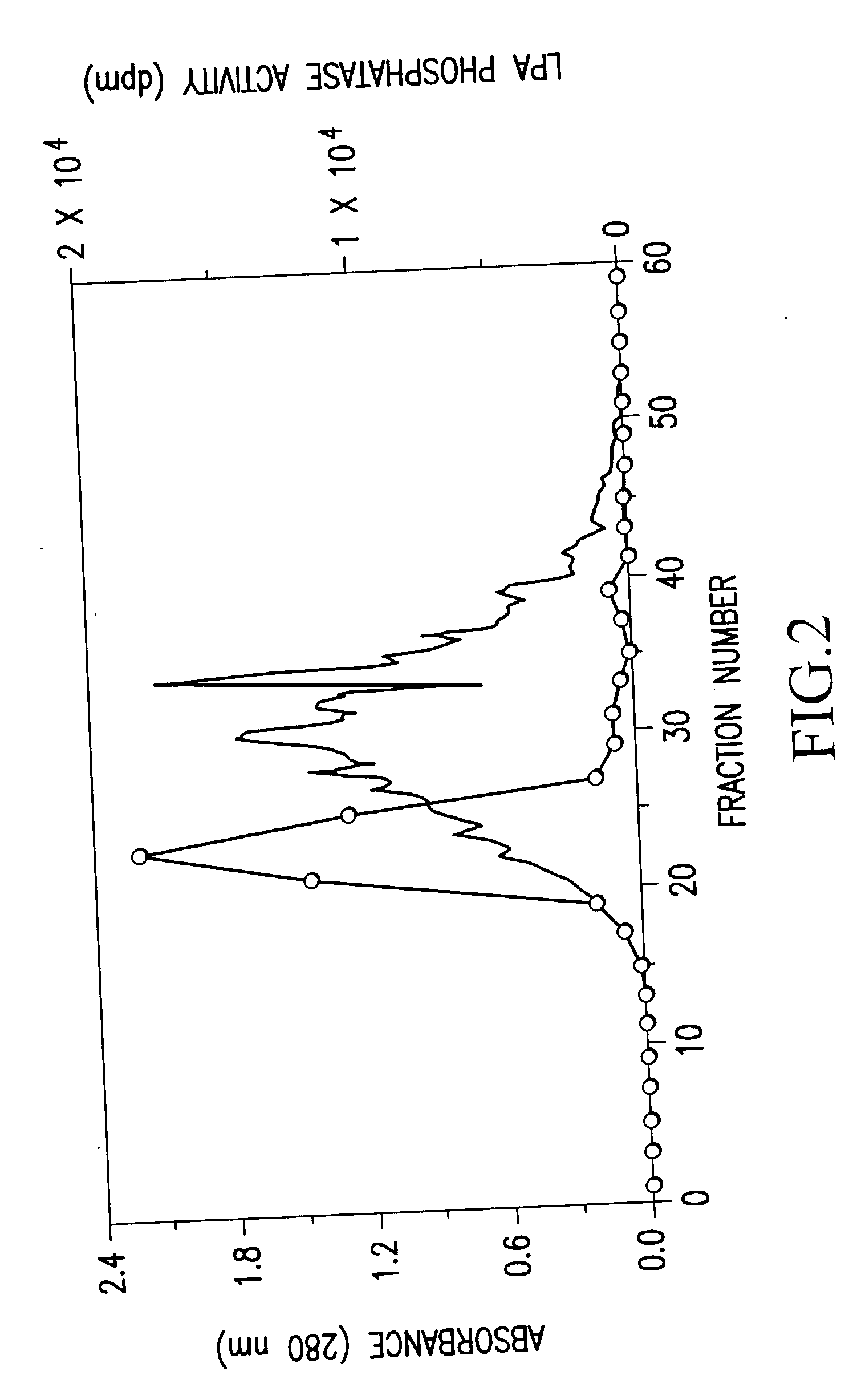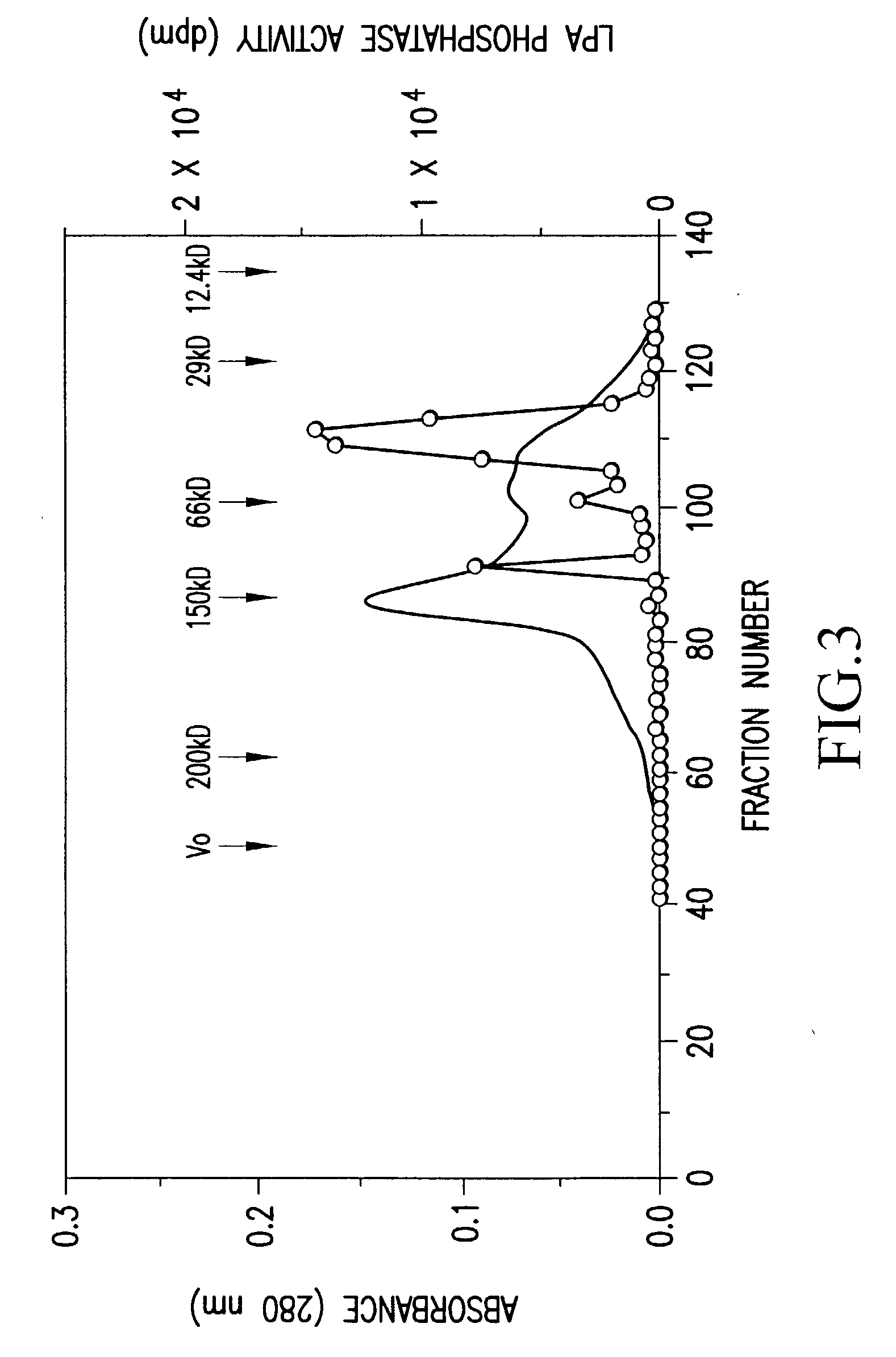Recombinant lysophosphatidic acid phosphatase
a lysophosphate and phosphatase technology, applied in the field of lysophosphatidic acid phosphatase, can solve the problems of complicated procedures, long time period, and not yet known lpa-specific phosphatase, and achieve the effect of simple and inexpensive determination of lpa
- Summary
- Abstract
- Description
- Claims
- Application Information
AI Technical Summary
Benefits of technology
Problems solved by technology
Method used
Image
Examples
example 1
Determination of Partial Amino Acid Sequence of Bovine LPA Phosphatase
[0123] The bovine LPA phosphatase (20 .mu.g) obtained in Preparation Example 1 was subjected to 7.5% SDS-PAGE, and transferred to a PVDF membrane (manufactured by ATTO) by using TRANS-BLOT SD SEMI-DRY TRANSFER CELL (manufactured by Bio-Rad). The membrane was stained with pigment (Ponceau.RTM., manufactured by Tokyo Kasei), and a desired band was cut out. Thereafter, a protein was cleaved with lysylendopeptidase, and extracted with acetonitrile. This extract was fractionated with HPLC C18 column, and 6 peaks were analyzed by Edman degradation method using a peptide sequencer (PPSQ-10 Protein Sequencer, manufactured by SHIMADZU).
[0124] As a result, it was found that the above six peptides had the following sequences:
2 peak 1: MVQVVFRHGARSPL (SEQ ID NO: 3); peak 2: FLNTISVYTLSPEK (SEQ ID NO: 4); peak 3: EGPIVISTDEAK (SEQ ID NO: 5); peak 4: EWFVQLYYRGK (SEQ ID NO: 6); peak 5: VGMEQMFALGERLRI (SEQ ID NO: 7); and peak 6...
example 2
Expression of Human LPA Phosphatase in E. coli
[0137] The human LPA phosphatase obtained in Example 1 comprises a signal peptide at N-terminal. hen the protein was expressed in E. coli, there is a possibility that the signal peptide is cleaved. When a protein resulting from fusion of N-terminal of the human LPA phosphatase with other proteins is expressed in E. coli and purified, there are deduced the difficulty of purification caused by cleavage of the signal peptide and the lowering of the phosphatase activity. Therefore, in this example, a construct carrying a sequence encoding a signal peptide and a construct without such a sequence were prepared.
[0138] PCR was carried out with LPA phosphatase cDNA cloned into pBluescript.RTM. II SK(-) obtained by the secondary screening of Example 1 as a template, by using the following primers:
4 (1) without signal peptide forward: (SEQ ID No:11) 5'-(cgcggatcc)ctgaagttgaaaatggtgcag-3' reverse: (SEQ ID NO:12) 5'-(cgcggatcc)ag-ttactcttcatttccaactt...
example 3
Preparation of 6.times. His-Tagged LPAP
[0151] E. coli was selected as host cells, and pQE-30 (QIAGEN) was used as an expression vector.
[0152] PCR was carried out with the LPA phosphatase cDNA cloned into pBluescript.RTM. II SK(-) obtained by the secondary screening of Example 1 as a template, by using the following primers:
5 forward: (SEQ ID NO:11) 5'-(cgcggatcc)ctgaagttgaaaatg-gtgcag-3' reverse: (SEQ ID NO:12) 5'-(cgcggatcc)agttactcttcatttccaacttc-3'
[0153] wherein "ggatcc" in the parentheses indicates BamHI site.
[0154] The temperature cycles consisted of:
[0155] 95.degree. C. for 3 minutes;
[0156] 10 cycles of 95.degree. C. for 30 seconds, 55.degree. C. for 1 minute, and 72.degree. C. for 2 minutes;
[0157] 30 cycles of 95.degree. C. for 30 seconds and 72.degree. C. for 2 minutes; and
[0158] 72.degree. C. for 10 minutes.
[0159] The resulting PCR amplified product was cleaved with BamHI restriction endonuclease (manufactured by NEW ENGLAND Biolabs), and subjected to 1% agarose gel electro...
PUM
| Property | Measurement | Unit |
|---|---|---|
| pH | aaaaa | aaaaa |
| concentration | aaaaa | aaaaa |
| pH | aaaaa | aaaaa |
Abstract
Description
Claims
Application Information
 Login to View More
Login to View More - R&D
- Intellectual Property
- Life Sciences
- Materials
- Tech Scout
- Unparalleled Data Quality
- Higher Quality Content
- 60% Fewer Hallucinations
Browse by: Latest US Patents, China's latest patents, Technical Efficacy Thesaurus, Application Domain, Technology Topic, Popular Technical Reports.
© 2025 PatSnap. All rights reserved.Legal|Privacy policy|Modern Slavery Act Transparency Statement|Sitemap|About US| Contact US: help@patsnap.com



